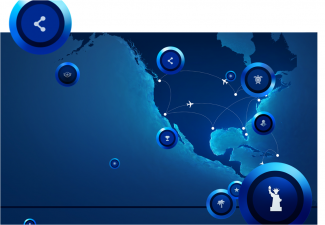TrueBlue Badges: Enhancing Loyalty, Engagement and Brand Awareness through Digital Gamification
425 different badges. 185,000 members. 57,000 partner badges earned. 133 million TrueBlue points awarded. As vice president of digital, loyalty and customer insights at JetBlue, Michael Stromer has direct access to some impressive stats. During his presentation at America’s Customer Festival 2014, Stromer revealed some of those stats and provided insight into TrueBlue Badges, the social-engagement extension of JetBlue’s loyalty program.
When JetBlue was founded in 1999, the airline set out to “bring humanity back to air travel” and present its customers with an improved flying experience. Fifteen years later, the airline has succeeded in its mission: JetBlue has ranked highest in customer satisfaction among low-cost carriers 10 years in a row, and TrueBlue was just named the “Best Airline Rewards Program.” Stromer explained that JetBlue’s digital refresh, which started in 2011, is an evolution of JetBlue’s original mission; a way of maintaining the airline’s core principles while also adapting to a technologically advanced environment. Mission Statement 2.0: “Inspire humanity through digital by providing an experience that is technologically advanced, yet exceptionally human.”
Why TrueBlue Badges?
TrueBlue Badges is a major part of the digital refresh that keeps JetBlue ahead of the competition. Badges puts TrueBlue members on a level playing field, giving everyone the chance to earn points toward a reward flight – something previously impossible for the many travelers that may only fly once or twice per year. By giving rewards for non-flight activities, JetBlue has developed a unique way of engaging and incentivizing its customers, even when they’re not traveling. Badges members can earn points for things like sharing on social media, interacting with the program’s partners, or simply connecting with other members.
As the name implies, the points often come along with actual badges that members can collect. These badges, along with interactive user maps and leaderboard rankings, represent the gamification elements that are central to the overall user experience of TrueBlue Badges. According to Stromer, the badges are designed to instill certain feelings in members: honor, bragging rights, progression and retention.
Most importantly, the badges are meant to make their members feel as though they are vested in the program – vested, not handcuffed, Stromer clarified. He shared a common sentiment among members of other frequent flyer programs: “I hate Airline ABC, but I have to keep flying with them. I already have so many points saved up … I need to cash in.” That type of feeling is exactly what JetBlue doesn’t want for its TrueBlue members. Instead, the airline takes a different approach to developing loyalty.
“JetBlue wants its members to be vested in its loyalty program because of an overall positive experience,” Stromer said. “And not because they feel obligated or trapped.” This approach has worked well for JetBlue. The airline’s continuous dedication to its customers has successfully redefined loyalty in the air-travel space, with JetBlue not only maintaining loyal members, but also turning those members into genuine fans.
What’s Next?
Stromer shared that JetBlue is looking to implement further mobile integration in the future. With smartphones and other devices becoming primary touch points for travelers, it is important to motivate loyal customers to interact across multiple channels.
“The connection between digital and loyalty marketing is stronger than ever,” he explained. “Don’t let it just be a points system.”
Stromer also stressed the importance of co-branded credit cards, stating that they are an important aspect to comprehensive multi-partner loyalty programs.